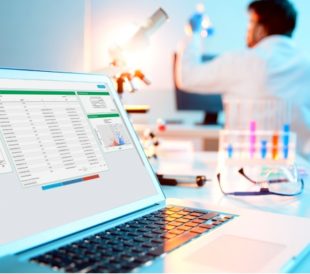At the 14th European Bioanalysis Forum (EBF) Open Symposium 2021, Thermo Fisher Scientific presented “Solution towards a vendor-neutral and secure transfer of data between LIMS and instruments.” The presentation summarized a joint vendor project exploring connections between laboratory information management systems (LIMS) and liquid chromatography-mass spectrometry (LC-MS) instruments using vendor-neutral data formats.
The project began in response to a white paper entitled “Improving data integrity in regulated bioanalysis: proposal for a generic data transfer process for LC–MS from the European Bioanalysis Forum,” published in Bioanalysis. The white paper highlighted a gap between the health authority’s data integrity expectations and the availability of software that meets these expectations in securely transferring data between a LIMS and LC-MS instruments. To mitigate data integrity risks and negate the need for manual and time-consuming quality-control steps, a vendor-neutral, secure, file-based interface solution was proposed and presented at the 13th EBF Open Symposium in November 2020. The project was a joint effort of the user and vendor community to create a vendor-neutral, standards-based solution. The team included representatives from Thermo Fisher Scientific, Shimadzu Corporation, SCIEX, and BSSN Software.

This year, the team highlighted the key advantages of the solution. The solution is based on an open standard AnIML data format and utilizes widely used digital signatures for security. Data flow is accomplished with a near zero impact on user workflows. This solution is designed to make a high impact on data integrity gaps and avoid further forced measures and process modifications due to inspection findings.
Limitations of traditional data transfer cycle
The traditional data transfer cycle between a LIMS and an LC-MS instrument is accomplished using a combination of ASCII files and server folders. Generally, the LIMS generates a sequence.txt file to begin the process. The file is stored on a server for retrieval by the LC-MS instrument. The LC-MS batch editor imports the file, and the acquisition process can begin. After acquisition and data processing, the LC-MS creates an export.txt file from the results table and saves the file to a departmental server. The LIMS then imports the export.txt file to capture the results.

Traditional data transfer cycle
While the process achieves the goal of data transfer, there are limitations. In many cases, the process of importing and exporting files is manual. Security is also limited in this setup, since anyone with folder access could modify the files without evidence of tampering. File formats are also proprietary, so it can be challenging for LIMS and instruments from different vendors to communicate.
Securing and standardizing data transfer
With the limitations of the traditional data transfer cycle in mind, the team set out to build a new solution to improve data integrity and security. Worklist/result information is transferred as a vendor neutral XML file format, replacing the previously used txt files. The data model is derived from the AnIML format, providing flexibility and the ability to scale beyond LC-MS workflows. The content of the files was identified in the EBF white paper and can easily scale to include more fields. The format is open to all instrument providers. XML files are easy to read and write and are well understood by the development community. The technology is widely adopted and provides a vendor-neutral solution. No bespoke interfaces are required in the solution, reducing implementation and validation cost.
For improved security, the XML files in the new solution are digitally signed using Public/Private key logic provided by the World Wide Web Consortium (W3C) Signature Working Group. Digital signatures make the data attributable, since you can tell who made a signature. They also provide tamper evidence in cases where the data is changed after signing. The import processes on both the LIMS and LC-MS are designed to verify the signature before accepting and importing the file. File provenance is confirmed before import, helping automate validation. Data security is managed by the software and is not exposed to the user.
What’s next
The project team noted that the solution is a first step toward improved data security, streamlined regulatory audits and a new standard for moving data between a LIMS and instruments. The team emphasized the need for additional participation from pharmaceutical companies, regulators, partner consortia (AAPS) and vendors to expand and refine the solution. The team also recommended an additional working group to expand into other assays and techniques, and to explore file-less options for data transfer.
If you’re interested in learning more about the project, joining a group of early adopters to refine the approach, or participating in a working group focused on next steps, visit instrumentlink.org. The site includes a Github repository with project documentation and example files.



Leave a Reply